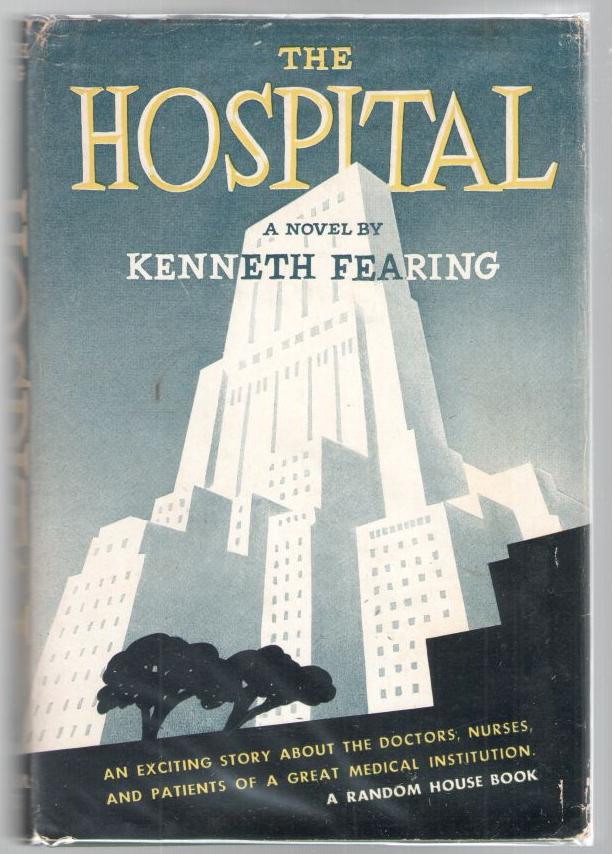“I’ll never get used to this hospital smell of antiseptic, not even after all the times I visited Alice in Bellevue. It’s the smell of the grave. Think of something without that smell. Think of something that hasn’t any smell at all, think of something blue. Blue and green.”
Kenneth Rexroth famously described Kenneth Fearing as a poet who “thought . . . like a taxi driver reading a billboard while fighting traffic.” Once, Fearing was asked by a D.C. District Attorney at the beginning of the McCarthy era if he was a member of the Communist Party, to which he replied, “Not yet.” However, Fearing is known today, if he is known at all, as a brilliant poet able to capture the rhythms of everyday speech and convert them into something profound and deeply poetic. But Fearing was more than a poet; he wrote novels too, the most famous of which is “The Big Clock,” later made into a classic film noir.
One reason for Fearing’s relative lack of fame as a social critic novelist compared to Nelson Algren and others writing at the same time and in the same vein, is that in Fearing’s fiction, character is subordinated to an investigation of institutions. Nowhere in Fearing’s novels , for instance, do memorable personalities such as Algren’s Frankie Machine (“The Man With the Golden Arm”) or Cass McKay (“Somebody in Boots”) emerge. Instead, Fearing’s characters are mostly anonymous vessels for larger themes and don’t particularly stand out as well-developed, distinct individuals, in large part because Fearing started off writing for the “hard boiled” detective pulps where elaborating character was secondary to executing a fast-paced plot. Instead in some ways the main character in Fearing’s fiction, always looming in the background, was what he called “The Shakedown”: the workings of American capitalism channeled through its institutions.
“The Hospital” was Fearing’s first novel and although supposedly it went through four printings in as many weeks after being released in 1939, has been out of print for more than half-century. It is unlikely to be reprinted. But reading it today still resonates; it functions as a documentary on a certain set of social relations that are long gone, but have more than mere historic interest. One of the novel’s striking techniques is how it cycles through perspectives, with each short chapter – most are no longer than 4-5 pages – capturing a single character’s thoughts. One character is a middle-aged single woman anxiously awaiting the result of a TB test and later, a lobectomy to remove a diseased lung. She drops out of the narrative for a long stretch but finally reappears at the end when a worker on a boat casually reads out loud her name on a manifest for caskets destined for burial in a pauper’s grave on Hart Island off the Bronx.
But even though the hospital brings together people – doctors and patients, nurses and janitors – every day and whose labor and tragedies, their births and their deaths, play out socially, people remain walled off from one another. As one patient thinks to herself watching a bored hospital receptionist call out names in a clinic:
“How many hundreds and hundreds of names has she called, how many patients has she seen go through that door, not knowing and not caring very much about what they feel, what they want or what becomes of them? No more interested in them, I guess, than I’m interested in the Italian-looking boy on one side or me and the old gray woman on the other. That’s the hardest thing there is to learn, that people aren’t very much concerned with other people, just those they know and those they trust and there are so few of them, that and the fact that you can’t expect them to be any different. They have to be that way and so do you. It’s hard to lean that. I wonder if anyone does.”
Occasionally, some sense of collective interest crops up. Someone in maintenance says to another worker, “I hate snoops. There’s enough natural-born squealers around this place without having a rat that’s paid to spy on top of all the others that do it for nothing. And all of the stool-pigeons they might have picked, it had to be a jerk like Cleary. You know Devoigne had him planted in the White Spray factory, the time they had that strike a couple years ago?” There’s regular references to unions and strikes scattered throughout and the blue-collar hospital workers have genuine human bonds doctors and management don’t. But mostly the hospital itself, an institution created by social labor, remains impervious to human intervention. It kind of rolls along, hovering above and alienated from the people within its walls.
Although Fearing shied away from didactic preaching – he was no ham-fisted proletarian novelist with a Message for the Masses- he was one of the first American novelists to perceptively diagnose the intertwined growth of bureaucracy, mass consumerism and mass loneliness which continues today in ever more metastasized forms. If for nothing else, his fiction needs to be read as the prescient work of a pioneer staking out the borders of an ever-expanding form of alienation “as American as apple pie,” to repurpose H. Rap Brown’s famous phrase about American violence.

